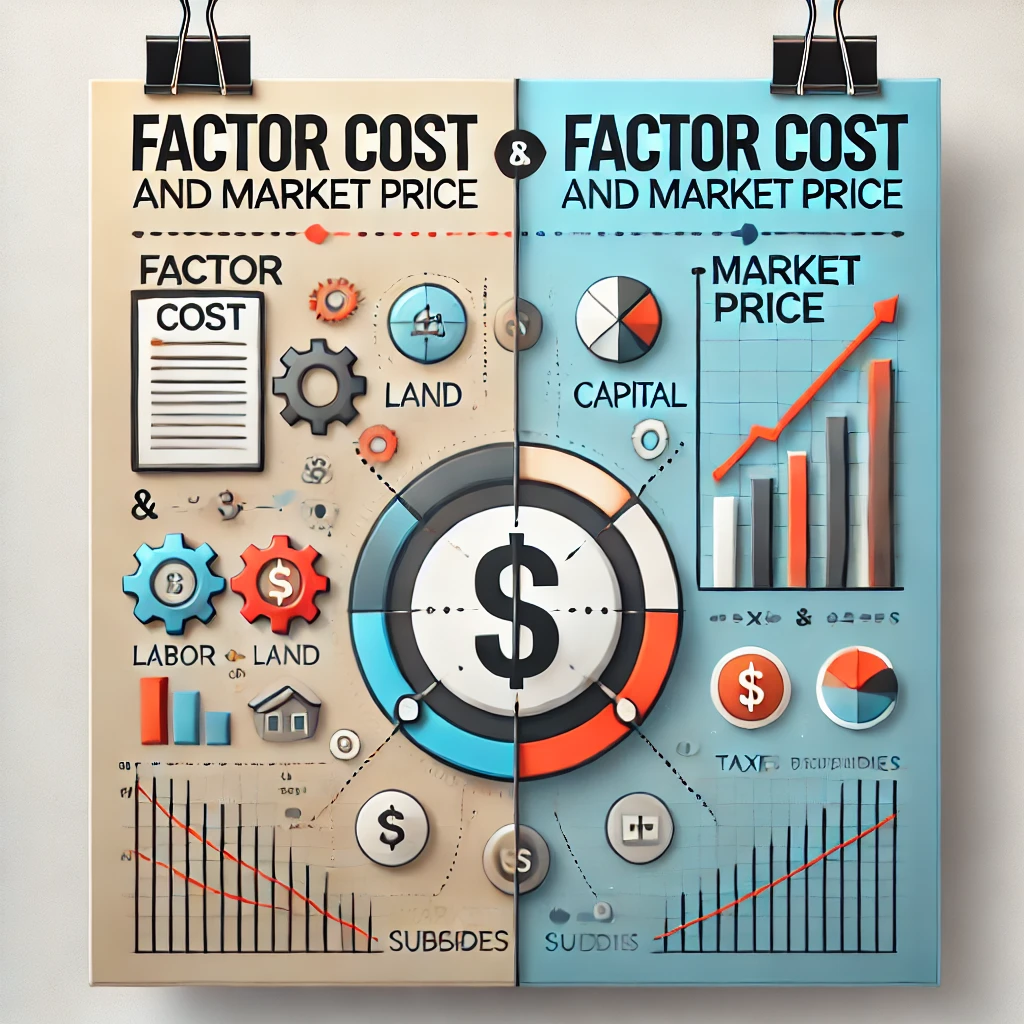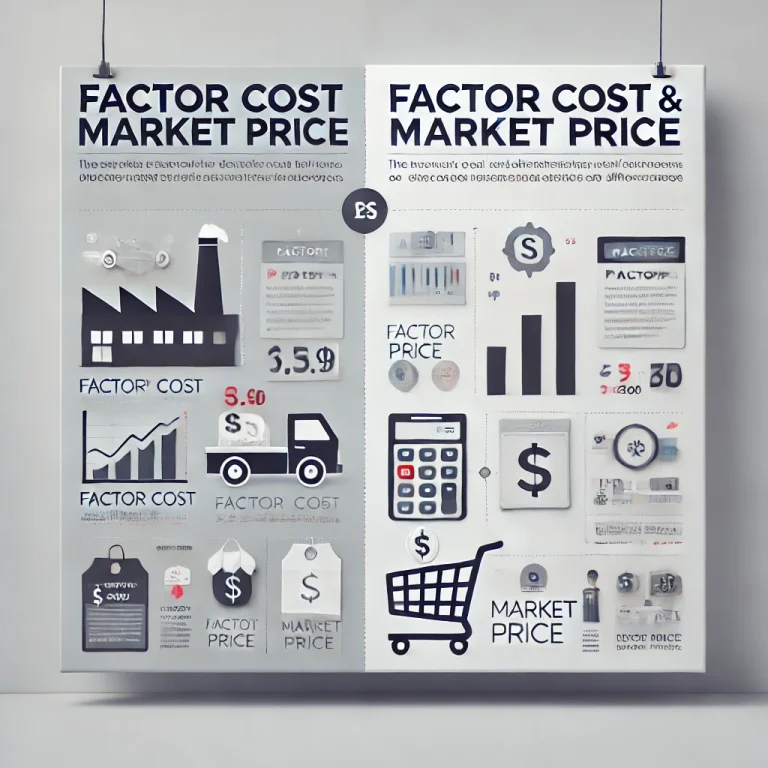Concepts of “factor cost and market price” aid in the interpretation of how GDP is computed and taken into the economic context. The terms factor cost and market price are two important terms generally found while using economic analysis. Factor cost can be conceptualized in simple terms as the total cost of producing goods and services within a country, which includes wages, rent, interest, and profit. The market price is the price at which final goods and services are sold in the market, including indirect taxes minus subsidies.
Factor Cost GDP and Market Price GDP are very important concepts for the student and analyst who wants to interpret the performance of an economy rightly.
What is Factor Cost?
Factor cost is defined as the cost incurred by the producers to produce goods and services. It indicates how much is spent on factors of production, such as labor, land, capital, and entrepreneurship. In simpler words, factor cost includes all the remittances made to employees, landlords, capital providers, and entrepreneurs who are actively involved in producing goods and services.
For example, if a business produces furniture, the factor cost would include the wages paid to the employees, factory rent, loan interest utilized to finance the business, and the profit realized by the business firm.

GDP at Factor Cost
Gross Domestic Product at factor cost means the total of all factor incomes, including wages, interest, rent, and profit of an economy generated within a specific period, usually one year. It is calculated by its producers’ income from the production of goods and services, minus tax and subsidies.
For example, if the GDP calculated at the factor cost of a country is $1 trillion, that is to say, the total amount of income received by labor, capital, and other factors of that country is $1 trillion, with no tax or subsidy factored in.
Key Features of GDP at Factor Cost:
- Wages: Payments made to labor for their contribution.
- Rent: Payment to landowners for using their property.
- Interest: Payments made for the use of capital.
- Profit: Earnings of entrepreneurs after covering costs.
This measure gives a clear picture of the income distribution in an economy and helps policymakers understand the returns to different factors of production.
Market Price Meaning
Market price refers to the actual price the consumers pay for the goods and services in the market, including taxes like VAT (Value Added Tax), excise duties, and import duties, as well as subsidies provided by the government.
In other words, it is the sum received for a product after indirect taxes have been added to and the amount of subsidy subtracted from its cost. For example, if it has a cost of $100 by factors of production and the government levies an amount of $10 as tax along with granting a subsidy of $5, then its market price would be $105.
GDP at Market Price
Gross Domestic Product at market price adds up the value of everything produced within a country, measured at the price to consumers. As such, it does reflect the gross value of production, including taxes but excluding subsidies on products.
Key Features of GDP at Market Price:
- Taxes: GDP at market price includes indirect taxes like VAT and excise duties, which increase the price consumers pay.
- Subsidies: These are deducted from the factor cost to reflect the market price.
For example, if a nation’s GDP at factor cost is $1 trillion, but it has $50 billion in indirect taxes and $10 billion in subsidies, the GDP at market price would be $1.04 trillion.
Difference Between Market Price and Factor Cost
Understanding the difference between market price and factor cost is essential for accurate GDP calculation and economic analysis. Here’s how they differ:
| Basis | Factor Cost | Market Price |
|---|---|---|
| Definition | Excludes indirect taxes and includes subsidies. | Includes indirect taxes and excludes subsidies. |
| Taxes/Subsidies | Doesn’t account for indirect taxes. | Accounts for indirect taxes and removes subsidies. |
| Usage | Used to measure income from production. | Used to measure expenditure on consumption. |
| Focus | Earnings of producers (wages, rent, etc.) | Final price paid by consumers. |
How to Calculate GDP at Market Price and Factor Cost
1. GDP at Market Price
To calculate GDP at market price, use the following formula:
GDP at Market Price = GDP at Factor Cost + Indirect Taxes – Subsidies
2. GDP at Factor Cost
To calculate GDP at factor cost, the formula is:
GDP at Factor Cost = GDP at Market Price – Indirect Taxes + Subsidies
These formulas help economists adjust the GDP for the taxes and subsidies to reflect different perspectives on the value of goods and services produced.
Conclusion
In conclusion, understanding factor cost and market price is crucial for interpreting GDP, as both provide insights into different aspects of economic performance. GDP at factor cost focuses on production income, while GDP at market price includes the impact of taxes and subsidies on the final value of goods and services. Knowing how to calculate and differentiate between these two measures allows policymakers and analysts to assess both the income generated by production and the actual expenditure on goods and services.
Factor Cost and Market Price FAQs
What is GDP at market price?
GDP at market price is the total value of goods and services produced in a country, including indirect taxes and excluding subsidies.
How is GDP at factor cost calculated?
GDP at factor cost is calculated by subtracting indirect taxes and adding subsidies to GDP at market price.
What is the difference between factor cost and market price?
Factor cost excludes indirect taxes and includes subsidies, while market price includes taxes and excludes subsidies.
Why is GDP at market price higher than GDP at factor cost?
GDP at market price is generally higher than GDP at factor cost because it includes indirect taxes.
How do indirect taxes affect GDP at market price?
Indirect taxes increase the GDP at market price because they raise the final price of goods and services sold to consumers.


